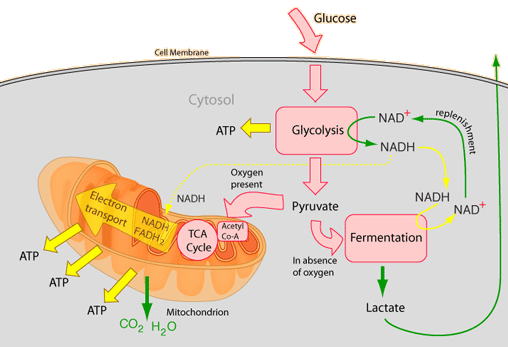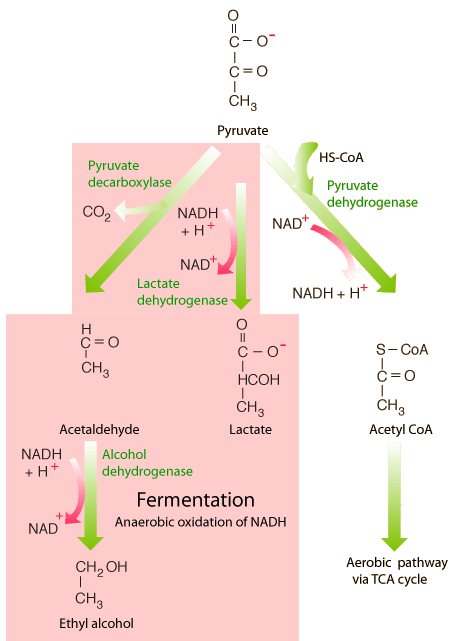http://hyperphysics.phy-astr.gsu.edu/hbase/biology/celres.html
Cell Respiration - Aerobic vs Anaerobic
Cellular Respiration
The term cellular respiration refers to the biochemical pathway by which cells release energy from the chemical bonds of food molecules and provide that energy for the essential processes of life. All living cells must carry out cellular respiration. It can be aerobic respiration in the presence of oxygen or anaerobic respiration.
Prokaryotic cells carry out cellular respiration within the cytoplasm or on the inner surfaces of the cells. More emphasis here will be placed on eukaryotic cells where the mitochondria are the site of most of the reactions. The energy currency of these cells is ATP, and one way to view the outcome of cellular respiration is as a production process for ATP.

________________________________________ |
The graphic below serves as a reminder of some of the processes involved in cellular respiration.

Cellular respiration produces CO2 as a metabolic waste. This CO2 binds with water to form carbonic acid, helping to maintain the blood's pH. Since too much CO2 would lower the blood's pH too much, the removal of the excess CO2 must be accomplished on an ongoing basis.
________________________________________ |
Aerobic Respiration
Aerobic respiration, or cell respiration in the presence of oxygen, uses the end product of glycolysis (pyruvate) in the TCA cycle to produce much more energy currency in the form of ATP than can be obtained from any anaerobic pathway. Aerobic respiration is characteristic of eukaryotic cells when they have sufficient oxygen and most of it takes place in the mitochondria.
________________________________________ |
Anaerobic Respiration
The first step in cellular respiration in all living cells is glycolysis, which can take place without the presence of molecular oxygen. If oxygen is present in the cell, then the cell can subsequently take advantage of aerobic respiration via the TCA cycle to produce much more usable energy in the form of ATP than any anaerobic pathway.
Nevertheless, the anaerobic pathways are important and are the sole source of ATP for many anaerobic bacteria. Eukaryotic cells also resort to anaerobic pathways if their oxygen supply is low. For example, when muscle cells are working very hard and exhaust their oxygen supply, they utilize the anaerobic pathway to lactic acid to continue to provide ATP for cell function.
Glycolysis itself yields two ATP molecules, so it is the first step of anaerobic respiration. Pyruvate, the product of glycolysis, can be used in fermentation to produce ethanol and NAD+ or for the production of lactate and NAD+. The production of NAD+ is crucial because glycolysis requires it and would cease when its supply was exhausted, resulting in cell death. A general sketch of the anaerobic steps is shown below. It follows Karp's organization.

Anaerobic respiration (both glycolysis and fermentation) takes place in the fluid portion of the cytoplasm whereas the bulk of the energy yield of aerobic respiration takes place in the mitochondria.
Anaerobic respiration leaves a lot of energy in the ethanol or lactate molecules that the cell cannot use and must excrete.
________________________________________ |
http://hyperphysics.phy-astr.gsu.edu/hbase/biology/celres.html
|